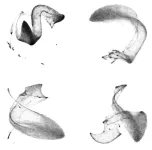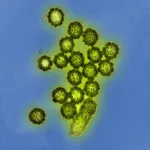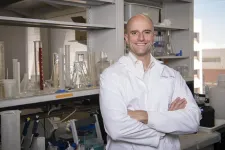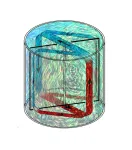(Press-News.org) The more, the better
“TomoTwin paves the way for automated identification and localization of proteins directly in their cellular environment, expanding the potential of cryo-ET,” says Gavin Rice, co-first author of the publication. Cryo-ET has the potential to decipher how biomolecules work within a cell and, by that, to unveil the basis of life and the origin of diseases.
In a cryo-ET experiment, scientists use a transmission electron microscope to obtain 3D images, called tomograms, of the cellular volume containing complex biomolecules. To gain a more detailed image of each different protein, they average as many copies of them as possible – similar to photographers capturing the same photo at varying exposures to later combine them in a perfectly exposed image. Crucially, one has to correctly identify and locate the different proteins in the picture before averaging them. “Scientists can attain hundreds of tomograms per day, but we lacked tools to fully identify the molecules within them,” says Rice.
Hand-picking
So far, researchers used algorithms based on templates of already known molecular structures to search for matches in the tomograms, but these tend to be error-prone. Identifying molecules by hand is another option which ensures high-quality picking but takes days to weeks per dataset.
Another possibility would be to use a form of supervised machine learning. These tools can be very accurate but currently lack usability, as they require manually labelling thousands of examples to train the software for each new protein, an almost impossible task for small biological molecules in a crowded cellular environment.
TomoTwin
The newly developed software TomoTwin overcomes many of these obstacles: It learns to pick the molecules that are similar in shape within a tomogram and maps them to a geometric space – the system is rewarded for placing similar proteins near each other and penalised otherwise. In the new map researchers can isolate and accurately identify the different proteins and use this to locate them inside the cell. “One advantage of TomoTwin is that we provide a pre-trained picking model,” says Rice. By removing the training step, the software can even run on local computers – where processing a tomogram usually requires 60-90 minutes, runtime on the MPI supercomputer Raven is reduced to 15 minutes per tomogram.
TomoTwin allows researchers to pick dozens of tomograms in the time it takes to manually pick a single one, therefore increasing the throughput of data and the averaging rate to obtain a better image. The software can currently locate globular proteins or protein complexes larger than 150 kilodaltons in cells; in the future, the Raunser group aims to include membrane proteins, filamentous proteins, and proteins of smaller sizes.
END
Novel AI-based software enables quick and reliable imaging of proteins in cells
Max Planck researchers from Dortmund programmed a tool that accurately recognises and picks proteins in electron cryo-tomography, substituting troublesome hand selection
2023-05-15
ELSE PRESS RELEASES FROM THIS DATE:
Clinical trial of mRNA universal influenza vaccine candidate begins
2023-05-15
A clinical trial of an experimental universal influenza vaccine developed by researchers at the National Institute of Allergy and Infectious Diseases’ (NIAID) Vaccine Research Center (VRC), part of the National Institutes of Health, has begun enrolling volunteers at Duke University in Durham, North Carolina. This Phase 1 trial will test the experimental vaccine, known as H1ssF-3928 mRNA-LNP, for safety and its ability to induce an immune response.
The trial will enroll up to 50 healthy volunteers aged ...
UArizona Health Sciences researchers unlocking new answers in the quest for safer, more effective opioid therapy
2023-05-15
TUCSON, Arizona — University of Arizona Health Sciences researchers are taking the foot off the brake in their quest to improve opioid therapy while decreasing its side effects.
Led by John Streicher, PhD, a Department of Pharmacology associate professor in the UArizona College of Medicine – Tucson and a member of the UArizona Health Sciences Comprehensive Pain and Addiction Center, the researchers have expanded upon their previous research focused on one specific protein – heat shock protein 90 – and its role in opioid receptor activation and pain relief. Their prior investigations have ...
Dr. Laura Moyer elected as Fellow of ASM International
2023-05-15
Dr. Laura Moyer ’99 ’02G ’05 PhD, manager of metallography, light optical microscopy, and X-ray diffraction at Lehigh University, has been elected as a Fellow of ASM International, the leading association of engineers and scientists in the field of materials science.
The honor recognizes Moyer’s “outstanding leadership and technical contributions to the education of personnel in both manufacturing and academia,” benefitting the field of materials science and engineering. The ...
Researchers design smaller, lighter space-based imaging spectrometers with high spectral resolution
2023-05-15
Researchers have developed a new smaller, lighter design for space-based imaging spectrometers with high spectral resolution. These high-dispersion imaging spectrometers could be used onboard spacecraft or satellites to study the Earth’s atmosphere or the atmospheres of other planets.
James P. McGuire, Jr. from NASA’s Jet Propulsion Laboratory in Southern California will present the new research at the Optica Design and Fabrication Conference, which will take place 04 – 08 June 2023 in Quebec City, Canada.
“This spectrometer provides the same measurement capabilities as conventional designs, but at one tenth the ...
Sleep Research Society announces 2023 award recipients
2023-05-15
DARIEN, IL – Four individuals have been selected as the 2023 Sleep Research Society award recipients for their outstanding contributions to the SRS, sleep and circadian science, and public health. They will be recognized Monday, June 5, during the plenary session of the SLEEP 2023 annual meeting of the Associated Professional Sleep Societies in Indianapolis.
“The SRS awards recognize the highest achievements by sleep and circadian scientists whose work supports our mission to cultivate knowledge in the field and to optimize health and well-being,” said SRS President Namni Goel. “I congratulate these leaders ...
Physicists take the temperature of fluid flows and discover new role for turbulence
2023-05-15
A team of physicists has discovered a new role for a specific type of turbulence—a finding that sheds light on fluid flows ranging from the Earth’s liquid core to boiling water.
The research, which appears in the journal Proceedings of the National Academy of Sciences, centered on turbulent convection—the movement of fluid when heated from below.
“Our experiments reveal intricate movements between a free-moving body and thermal convective flows,” says Jun Zhang, a professor of mathematics and physics at New York University and NYU Shanghai, the paper’s senior author.
The study, which also included Kaizhe Wang, a researcher ...
Tiny proteins found across the animal kingdom play a key role in cancer spread
2023-05-15
Phosphatases of regenerating liver (PRLs) are a family of enigmatic proteins involved in cell growth and metabolism present in various species. From humans to fruit flies, they play a unique role in the growth of cancerous tumours and the spread of cancer throughout the body. New research emerging from McGill University is contributing to what is known about PRLs, which could potentially become an important tool in the development of cancer-fighting treatments.
Led by Kalle Gehring, a professor in the Department of Biochemistry and founding director of the McGill Centre for Structural Biology, the researchers focused on unravelling the mystery around PRLs. “It's ...
Great inequality in international athletics
2023-05-15
Athletes from less affluent countries need more education on health to prevent injuries during hard training. But, paradoxically, more knowledge can also increase the risk of injury if there is no access to medically trained expertise. This is the conclusion of researchers at Linköping University, Sweden, in a new study on inequality in athletics.
“There were astronomical differences in support resources between juniors from different parts of the world. European competitors had entire medical teams and computer-based analysis programs ...
New DOE portal connects researchers and students with climate science and training opportunities
2023-05-15
The National Virtual Climate Laboratory (NVCL), a comprehensive web portal for climate science projects funded by the U.S. Department of Energy (DOE) Office of Science’s Biological and Environmental Research (BER) program, is now available.
The NVCL is a portal for those who have a stake in the climate crisis, such as researchers, students, faculty, and other interested organizations. Portal users will be able to find a wide range of national laboratory experts, programs, projects, activities, ...
Alternating estrogen and anti-estrogen therapies is effective in treating metastatic breast cancer
2023-05-15
LEBANON, NH— Advanced or metastatic estrogen receptor-positive (ER+) breast cancer is commonly treated with drugs that block the estrogen receptor. However, estrogens that stimulate the receptor can also be effective. Building on their previous studies, researchers at Dartmouth Cancer Center recently concluded a Phase II clinical trial aimed to test the efficacy of alternating between estrogen stimulation and estrogen deprivation in patients with metastatic ER+ breast cancer, and to identify tumor characteristics that predict who might benefit from this strategy. The results, newly published ahead of print in Clinical ...
LAST 30 PRESS RELEASES:
Numbers in our sights affect how we perceive space
SIMJ announces global collaborative book project in commemoration of its 75th anniversary
Air pollution exposure and birth weight
Obstructive sleep apnea risk and mental health conditions among older adults
How talking slows eye movements behind the wheel
The Ceramic Society of Japan’s Oxoate Ceramics Research Association launches new international book project
Heart-brain connection: international study reveals the role of the vagus nerve in keeping the heart young
Researchers identify Rb1 as a predictive biomarker for a new therapeutic strategy in some breast cancers
Survey reveals ethical gaps slowing AI adoption in pediatric surgery
Stimulant ADHD medications work differently than thought
AI overestimates how smart people are, according to HSE economists
HSE researchers create genome-wide map of quadruplexes
Scientists boost cell "powerhouses" to burn more calories
Automatic label checking: The missing step in making reliable medical AI
Low daily alcohol intake linked to 50% heightened mouth cancer risk in India
American Meteorological Society announces Rick Spinrad as 2026 President-Elect
Biomass-based carbon capture spotlighted in newly released global climate webinar recording
Illuminating invisible nano pollutants: advanced bioimaging tracks the full journey of emerging nanoscale contaminants in living systems
How does age affect recovery from spinal cord injury?
Novel AI tool offers prognosis for patients with head and neck cancer
Fathers’ microplastic exposure tied to their children’s metabolic problems
Research validates laboratory model for studying high-grade serous ovarian cancer
SIR 2026 delivers transformative breakthroughs in minimally invasive medicine to improve patient care
Stem Cell Reports most downloaded papers of 2025 highlight the breadth and impact of stem cell research
Oxford-led study estimates NHS spends around 3% of its primary and secondary care budget on the health impacts of heat and cold in England
A researcher’s long quest leads to a smart composite breakthrough
Urban wild bees act as “microbial sensors” of city health.
New study finds where you live affects recovery after a hip fracture
Forecasting the impact of fully automated vehicle adoption on US road traffic injuries
Alcohol-related hospitalizations from 2016 to 2022
[Press-News.org] Novel AI-based software enables quick and reliable imaging of proteins in cellsMax Planck researchers from Dortmund programmed a tool that accurately recognises and picks proteins in electron cryo-tomography, substituting troublesome hand selection





